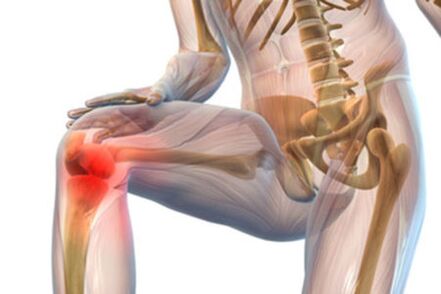
Arthropathy of the knee joint (knee arthropathy) is a degenerative disease of the joint, which eventually leads to its deformation. In it, cartilage tissue began to collapse. Gradually, the knee joint function is impaired, and the patient loses the ability to move normally. This disease is very common.
The treatment of knee joint disease is long-term, but it cannot completely cure the problem. However, in order to maintain joint mobility and functionality for as long as possible, and to improve the patient's quality of life, treatment is required.
Type of disease
According to the reasons for its development, the knee joint disease of the knee joint can be classified. It is primary and secondary. The first disease occurs most often. It also has another name-idiopathic osteoarthritis. Due to too many influencing factors, the exact cause of this knee joint disease is difficult to determine.
The second type of pathology is obviously related to one cause or another. For example, due to the intense physical exertion of the knee joint, it often occurs after knee injury. This knee joint disease is usually determined by genes. Certain diseases can also cause changes in knee dystrophy: diabetes, rheumatoid arthritis, congenital lower limb deformities.
Why pathology develops
The knee joint is one of the most complex joints in the human body. It consists of femur, tibia and patella. The joints also include triangular cartilage with curved edges-meniscus. The coordination of the knee joint is ensured by the muscle-ligament device. Almost all the bone surface of the joint is covered by cartilage tissue. The thickness of cartilage tissue is about 0. 5 cm. It feeds on blood vessels and also spreads (getting useful substances from synovial fluid).
The cartilage in the knee allows the surface of the bones to slide and cushion them. If the nutrition of this tissue is disturbed, then the process of malnutrition will begin in it, and it will become thinner. Without treatment, the cartilage disappears completely and the knee joint stops moving. The causes of joint disease may be different. For example, the following factors may cause the appearance of secondary pathology:
- Excessive pressure on the knee joint. In this case, there may be changes that people don't even know about. Therefore, the load should be moderate, especially for the elderly. The biggest injuries come from squatting and running on hard surfaces (asphalt).
- Knee injury. This may include meniscus injuries, joint dislocations, and fractures. This reason contributes to the development of diseases in young people. After the limb is fixed, its blood circulation deteriorates. 90% of meniscus injuries or removal will result in arthropathy.
- Overweight. Excessive weight will damage the meniscus. The recovery of the knee joint is long and difficult. Obese people often develop bilateral knee joint disease. Another negative factor is the presence of varicose veins. In this case, the patient will develop the most severe knee arthritis.
- Weakness of ligament organs. Because of this, the joint mobility is too high. Although a person can sit on the twine without any problems even without warming up, the joints will be slightly traumatized at this time. If the knee is damaged enough, arthropathy will begin to develop.
- Violation of the metabolic process. In this case, the knee joint cannot get enough nutrition.
- Joint disease. The pathology presented may be caused by knee joint arthritis (reactive, rheumatoid). It is characterized by the development of inflammation and the accumulation of excessive fluid in the joint cavity. The cartilage in the knee began to deteriorate.
- A stressful situation. Mood fluctuations and the continued presence of the nervous system under tension can cause arthropathy of the knee joint.
- Congenital diseases of muscles, ligaments and dysplasia.
- Chondrcalcinosis (premature deposition of calcium in the cartilage of the knee joint). Pathology is systemic.
- osteomyelitis. This is inflammation of the bone marrow in which purulent masses form. They have a negative impact on surrounding tissues. Over time, the purulent mass will extend beyond the bone of the knee joint. Lack of treatment threatens the development of sepsis.
- Acromegaly. This is an endocrine disease in which the level of growth hormone-growth hormone-rises. In most cases, benign tumors of the anterior pituitary gland will increase their numbers. If this disease occurs during adolescence, the child will develop a specific physique. The excessive growth rate of cartilage tissue causes the knee joint to deform.
- diabetes.
- Hypothyroidism. This disease is also endocrine. It occurs due to a lack of thyroid hormones. A person's weight starts to increase, his movements are few, and the cartilage of the knee joint wears out.
- frostbite. In this case, ice crystals form in the soft tissues, killing living cells.
- Synovitis (inflammation in the synovial pockets of joints).
All of these causes can cause gonorrhea in the knee joint, and people will not even notice when the disease begins to develop.
What stages has the development of arthropathy gone through?
The effectiveness of knee joint treatment depends on the degree of development of the patient’s diagnosed joint disease:
- Knee joint level. There is not much pain at this stage. The patient can endure discomfort for many years, and he is not in a hurry to contact a specialist or conduct any type of treatment. A person needs help during the deterioration period. Severe pain is not a typical feature of knee joint disease.
- Second degree knee joint arthropathy. The intensity of discomfort increases. Pain not only occurs after physical exertion of the knee joint, but also occurs during rest. In order to get rid of unpleasant feelings, you must rest more. In the knee joint area, there is swelling and the patient hears a crunch. X-rays showed narrowing of the joint space and slight deformation of the knee joint.
- Arthropathy of the third degree knee joint. In this case, the mobility of the knee is severely restricted, and sometimes the leg cannot be fully straightened. The joint pain becomes severe and persistent, which appears to be a response to changing weather conditions. This discomfort is painful in nature and it is difficult to get rid of it even at rest. The patient’s sleep is often disturbed. In order to at least slightly relieve his condition, he will use non-steroidal anti-inflammatory drugs. A person will limp and the joint deformities are very obvious.
Before the destruction of bone tissue becomes serious, the treatment of joint disease should be started as soon as possible. If irreversible changes occur, only surgery can help the patient.
Knee joint disease symptoms
The development of joint disease does not happen overnight. As it progresses, the symptoms become more severe. For knee joint disease, the following manifestations are characteristic:
- The creaking and clicking sound that accompanies a certain movement. The patient may not notice this symptom until late. However, he said the articular surface was damaged, with grooves and bone growth appearing on it.
- The knee is swollen and enlarged.
- Painful feeling. They are not visible in the first stage of the development of arthropathy and only appear after the knee joint is under severe static load. In turn, dynamic exercise can improve joint condition, nutrition and subsequent prognosis. As the top layer of cartilage is erased in arthropathy, nerve endings are exposed. After a while (after resting), the fibers are covered with a small layer of fibrin and become less sensitive-the knee pain disappeared. If the knee joint continues to collapse, it will not cause discomfort even when resting. Edema appears in the bursa of Fabricius, which will put more pressure on the nerves. The inflammatory process begins.
- Can not move. This symptom allows you to distinguish joint disease from other lesions of the knee joint. Stiffness appeared in the morning after going to bed and disappeared after half an hour. If this condition lasts longer, it indicates that there is an inflammatory process.
- The range of motion is reduced. The patient cannot straighten his limbs. Due to the constant pain the patient tried to reduce the range of motion, the ligaments adapted to this. That is, they are shortened and do not allow the knee joint to fully perform its function.
- Joint interference. It is caused by a strong change in the articular surface.
- Dislocation and subluxation. They appear in the final stage of the development of arthropathy, when the joints are severely deformed.
Over time, a person will experience muscle atrophy, osteophyte proliferation, and weakening of the lateral ligaments. When a person becomes disabled, the consequences of joint disease are serious.
How to correctly define joint disease?
In order to start the proper treatment of joint disease, the patient must undergo a thorough examination. The diagnosis should be differentiated and include the following studies:
- X-ray of the knee joint. For knee joint disease, it is performed in two projections. Experts need to perform X-ray examinations of damaged knees and healthy knees. Radiography allows you to identify the following signs of joint disease: narrowing of the joint space, osteophytes, and subchondral sclerosis. In addition, current research on the knee joint has revealed subluxation, the ossification of cartilage tissue.
- Arthroscopy. This is a minimally invasive surgery used not only for diagnosing arthropathy, but also for treating arthropathy. It allows the use of special LED conductors with a camera at the end. It is inserted through a small opening on the side of the knee. The full picture of the internal state of the joint is reflected on the monitor. However, this process has a disadvantage: the joints are in a state of decompression, and pathogenic microorganisms can enter it.
- Ultrasound. This diagnostic method is absolutely safe. This procedure helps to examine the soft tissues of the knee, as well as cartilage, synovium, and blood vessels.
- CT. This is an X-ray inspection method, but it not only allows you to see the bone structure, but also the soft tissues. With the aid of computer equipment, experts can build a 3D model of the knee. However, in order to obtain accurate information, the patient must receive a large amount of radiation.
- Flash scan. This is an X-ray examination using a contrast agent.
- Nuclear magnetic resonance. In this case, magnetic beams are used to obtain information. The picture shows clearer soft tissue.
- Thermal Imaging. The procedure is based on recording the heat radiation from the surface of the patient's body. Therefore, you can identify tumors and inflammatory lesions. A study is designated for differential diagnosis.
- General blood analysis. It helps to determine the severity of inflammation and its nature.
- General urine test. Thanks to him, it was possible to determine the systemic nature of the pathology.
- Blood chemistry.
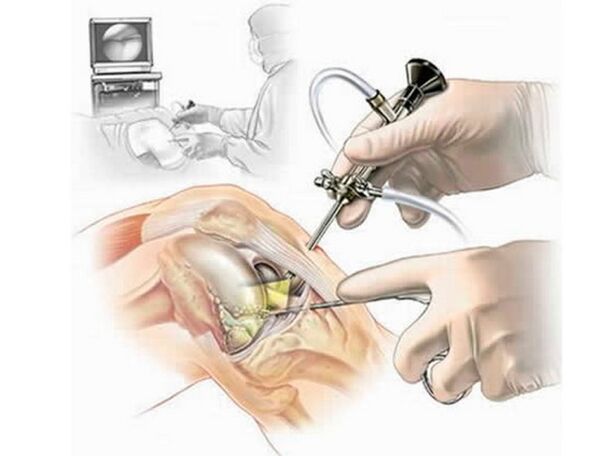
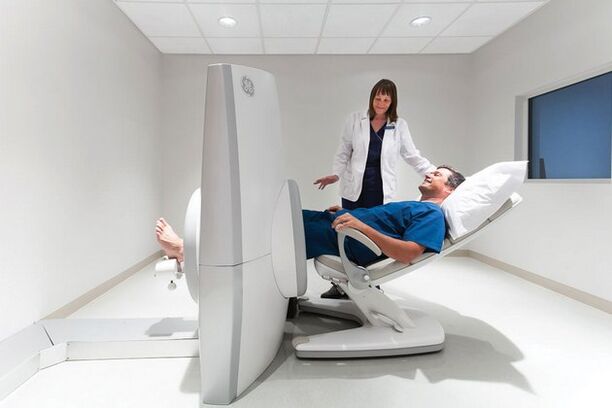
Thanks to these diagnostic measures, experts can accurately determine knee joint disease and prescribe truly effective treatments.
Knee joint disease treatment
The treatment of joint disease must be multifaceted and long-term. Since it is impossible to completely stop the destruction of joints, treatment must be continued to improve the quality of life of patients.
Drugs for treating joint disease
The doctor may prescribe the following drugs:
- Non-hormonal anti-inflammatory drugs. They are used in the form of tablets and ointments. However, for severe pain syndromes that cannot be eliminated by standard methods, injections can be used. It helps calm pain quickly, relieve swelling and reduce the intensity of inflammation. These remedies can only eliminate symptoms, but cannot cure arthropathy. Only doctors can prescribe these funds. The course of treatment does not exceed 14 days, and it will be relieved in 2-3 days.
- Cartilage protector for knee joint arthropathy. Each of these drugs contains useful substances that can regenerate cartilage. However, it will only be effective if you start the application on time. If the cartilage is completely removed, the use of chondroprotective agents will be useless. Treatment in this way will be long-term (at least 6 months). Although injections are possible, pills and topical medications are the most commonly used.
- Vasodilators. They help relieve cramps and pain syndromes, restore normal blood circulation, and improve the nutrition of the knee joint.
- Glucocorticoids. In most cases, they are used in the most difficult situations, when other drugs are not producing a positive effect. Intra-knee injections are used to treat arthropathy. They can only be used once a year.
- Enzyme. They provide for the regeneration of cartilage structures in the initial stages of knee joint development. They are also prescribed to be injected into the joints.
- Hyaluronic acid. It provides smooth movement of the knee joint because it can replace synovial fluid.
- Topical preparations-ointments, creams, gels. They can only relieve symptoms.
- Drug compression. In this case, the medicine used can penetrate the skin, help eliminate muscle clamps, and have a reabsorption effect. Medical bile can be used for compression.
Drug therapy is essential in the treatment of arthropathy. However, the drug must be used in strict accordance with the dosage prescribed by the doctor. Without the knowledge of experts, it is impossible to independently increase or decrease the rate and change the daily rate.
Characteristics of physiotherapy treatment and exercise therapy
You can also use physiotherapy procedures to treat knee joint arthropathy:
- massage. It helps restore normal blood circulation in the tissues and eliminate muscle spasms.
- Drug electrophoresis can eliminate joint inflammation and produce analgesic effects.
- Magnetic therapy. With the help of specific radiation, the tissues around the affected left and right joints are stimulated. The metabolic process in the cell is improved.
- UHF. The waves promote the production of synovial fluid, which lubricates the knee.
- Ultrasonography with corticosteroids.
- Electrotherapy not only helps to eliminate pain, but also helps to eliminate swelling.
- Mud therapy.
- Spa.
- Shockwave therapy.
- Heat treatment. This includes paraffin therapy. Thanks to this procedure, local blood circulation is improved.
- SMV therapy. This physical therapy can stimulate blood circulation, relieve swelling and help improve the nutrition of cartilage tissue.
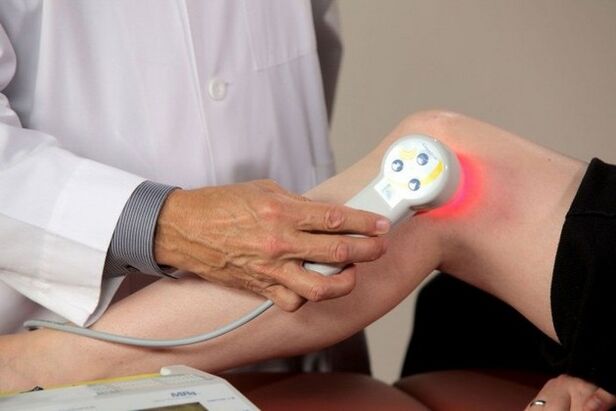
Physical therapy is very useful. It is necessary to restore the elasticity of muscle tissue and ligaments and improve the mobility of the knee joint. The following exercises will be useful:
- Lie on your stomach, you need to lift your legs in turn. In this case, they should not bend at the knees. The lifting height is approximately 20 cm.
- Lie on the left side with the left leg bent and raised 30 degrees. It is necessary to keep the limbs in this position for up to 30 seconds. The same exercise should be done for the right leg.
- Sit on a chair with your legs as straight as possible and raise them one by one.
A set of exercises is individually selected by the attending physician. Gymnastics is best performed after a small massage with ointment. Physical therapy is an effective additional method for the treatment of arthropathy, which can enhance the effect of drugs.
Do you need surgery?
In the most difficult cases, when the joint is severely damaged by the joint, the patient will be prescribed surgery. There are several types of interventions:
- Joint traction. It involves stretching joints damaged by arthropathy to increase the gap between cartilage. This will make it possible to prevent further tissue destruction and its gradual recovery.
- The endoprosthesis is a complete replacement for the joint damaged by arthropathy. It is done as a last resort. The replacement can be complete or partial. The prosthesis must be replaced within 10-15 years.
- Osteotomy. This treatment of arthropathy makes it possible to mechanically correct the deviation of severely deformed bones. In this case, the physical element will break at a strictly defined location. Next, the bones are correctly positioned and fused.
- Arthroscopy. With its help, it can repair the cartilage surface damaged by arthropathy. In addition, through arthroscopy, foreign bodies and bone fragments can be removed from the joint. This operation is used for excessive movement of the joints. Arthroscopy is considered a low-traumatic surgery, so postoperative recovery will not last long.
It is best not to bring it into surgical intervention. Treatment should begin in the first stage of the development of arthropathy. Orthopedic equipment will help consolidate the results: canes, load-reducing orthoses, knee pads with infrared radiation.
The use of folk remedies
It is impossible to completely cure joint disease because the degenerative process will gradually develop. However, you can eliminate the symptoms and prevent joint disease from destroying the knee joint. Folk remedies can be used during periods of deterioration or during periods of relative calm. But first you need expert advice. The following recipes are useful for joint disease:
- The chopped horseradish should be boiled in a small amount of water on a low heat. After that, the porridge must be filtered and placed around the knee affected by the joint. The compression pack must be secured with a bandage. You need to perform this procedure every day for a month. Compression can improve blood circulation and tissue repair.
- Applying any vegetable oil to the knee joint area to treat joint disease will help eliminate the pain. However, it needs to be heated slightly.
- The mummy provides good results. Need to mix 3-4 grams of raw materials with 100 grams of honey. You need to apply the medicine to the painful area at night before going to bed. Next, wrap the affected area with a warm scarf. The mummy inside is also welcomed. You can use 0. 2 grams per day.
- Fresh dandelion flowers can be cleaned thoroughly. Take 5-6 slices a day. Also dry 1 tablespoon of ingredients. You should pour a glass of boiling water and insist on drinking 1/3 cup 3 times a day.
- Rub the aloe leaves. It is necessary to twist 10 plants and squeeze them through cheesecloth. The juice is mixed with half a cup of honey and 150 ml of red wine. Pour the resulting product into a dark glass container and apply it every day for one month.
Cabbage and burdock leaves help relieve joint inflammation. Folk remedies cannot be considered a panacea, but they can increase the effectiveness of other types of therapies.
Nutritional rules for joint disease
The treatment of joint disease does not require a particularly strict diet, but you still need to follow some nutritional rules:
- Reduce salt intake. The total daily amount should not exceed 2 grams, and it is best to add salt before use instead of adding salt during the cooking process.
- The amount of spices used in the treatment of joint diseases should also be reduced. The same applies to fermented foods, kimchi. In general, it is best to exclude marinades and canned foods from the diet.
- Animal fat is not recommended.
- The menu should not include sweets, pastries and bread made from wheat flour.
- For joint disease, alcohol and nicotine are strictly prohibited.
- Dishes containing gelatin are useful: aspic, aspic, beef bone soup.
- The important thing for joint disease is the consumption of milk protein (the product should not be fat), fish, and seafood.
- The diet should include vegetable oils, vegetables and fruits, and freshly squeezed juices.
- A person should consume enough fluids every day.

The correct diet for joint disease should be formulated by an expert. Even if the patient is overweight, he cannot go to extremes. Vigorous and improper weight loss will only aggravate your health. In this case, treatment will be greatly delayed.
Prevent joint disease
In order to avoid the possibility of joint disease and not lose the ability to walk, you need to follow the following expert advice:
- We must not forget sports. It is best to go to the swimming pool, ride a bicycle, and hike in the fresh air. You can also go dancing.
- It is recommended to avoid any lesions and hypothermia of the knee joint, as this can cause post-traumatic arthropathy.
- Prolonged exercise is best to use protective knee pads or other orthopedic devices.
- It is recommended to wear comfortable shoes.
- The right diet is important-if all the necessary nutrients are provided to the joints on a regular basis, joint disease will not occur.
- If you have excess weight, you should get rid of it.
- It is best to avoid stress, and to arrange work and rest procedures correctly.
- It is necessary to strengthen the body's defense capabilities.
- All inflammatory or infectious pathologies that can cause the development of joint disease should be eliminated in time.
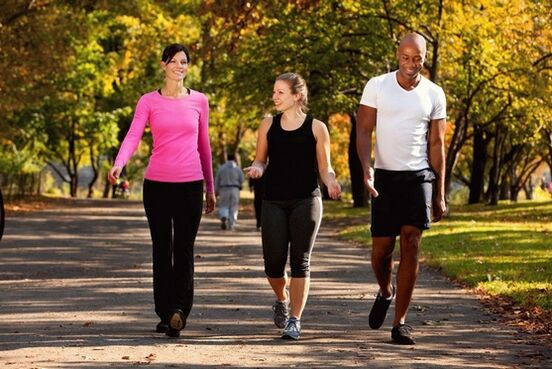
Proper prevention can significantly delay joint destruction, which is the body's natural aging process under normal circumstances.
Knee arthropathy is an incurable disease, but its progress can be slowed or even prevented by improving the quality of life.


























